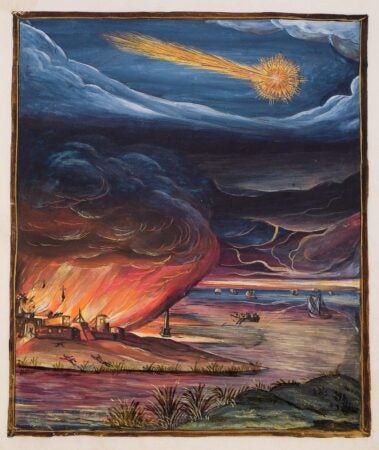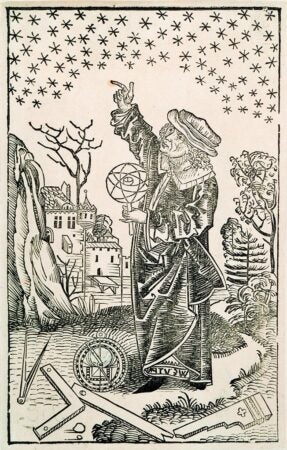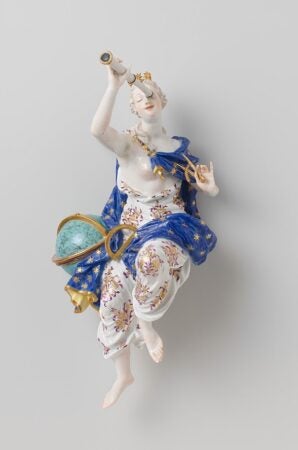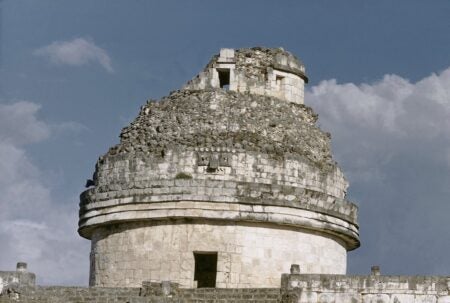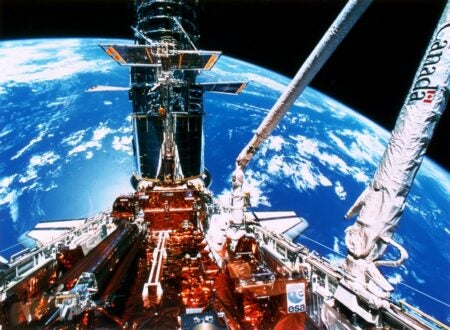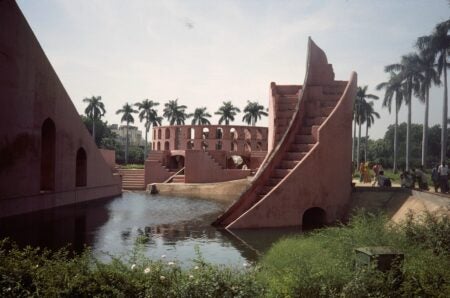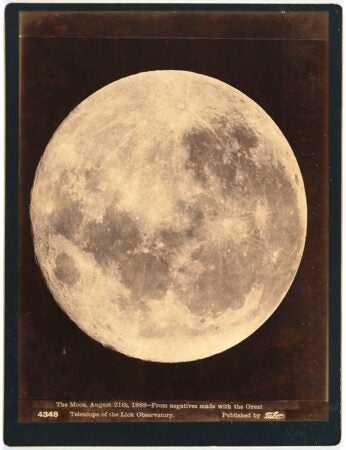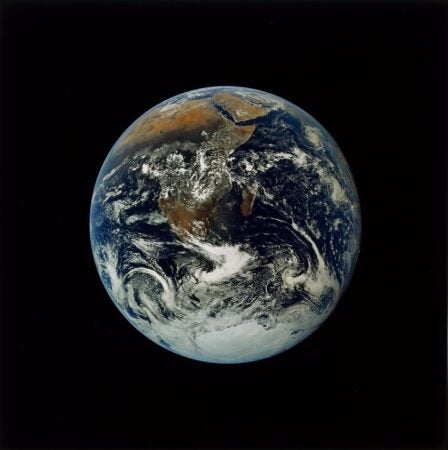Summer is for stargazers: Astronomy in Artstor
Summer solstice brings us the longest, sunniest days of the year. The season also sparkles with starry nights, and getaways in July and August provide an escape from the urban glare, enhancing our appreciation of stellar skies. In homage to the stars, we have mined the resources of Artstor to present some outstanding celestial subjects across the ages.
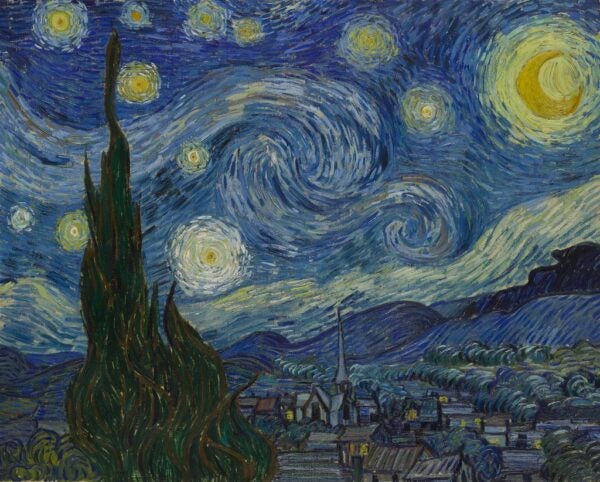
Vincent van Gogh. The Starry Night. 1889. Image and data provided by the Museum of Modern Art.
Starry Night, 1889, by Vincent van Gogh, exemplifies the genre of the nocturne. The artist’s unique style might lead one to believe that the entire scene is imaginary, but researchers have identified many of the planets depicted; to name one, Venus shines white above the horizon at left. Nonetheless, the painter took liberties with the moon, rendering it as a crescent when in fact it would have been a fuller waning gibbous on that night, June 18. In a letter to his sister written the previous year, van Gogh articulated his observation of star fields: “certain stars are citron-yellow, others have a pink glow, or a green, blue and forget-me-not brilliance… putting little white dots on a blue-black surface is not enough.” [1]
- Anonymous Dutch. Aurora Comet (or Matuta/Muzbah), leaf 17, from an illustrated treatise on comets, 1587. Image and original data provided by The Warburg Institute Library.
- Anonymous Dutch. Shooting stars, leaf 9, from an illustrated treatise on comets. 1587. Image and original data provided by The Warburg Institute Library.
From ancient times through the Enlightenment the movements of the galaxy were understood as elements of a holistic cosmology where astronomy, astrology, celestial, and spiritual forces all comprised the firmament. A treatise on comets from 1587 by a Dutch scribe and an artist (both anonymous), based on Ptolemaic principles, offers striking illuminations, including the phenomena of comets, aurora borealis, and even a sundog (an optical occurence that appears as luminous spots on each side of the sun). In one illustration, the comet Aurora pitches through the sky, parting clouds as an inferno consumes a village, while a gentle star shower animates the night in another. The text describes Aurora as a red star with a long raised tail bringing famine, drought, and fire. Comets (from the Greek meaning long-haired star) are balls of ice and dust with gaseous tails. They have been feared as harbingers of doom up to and even beyond the time of Isaac Newton.
- Michael Wolgemut. The Astronomer. c. 1490. Image and data provided by Bildarchiv Preussischer Kulturbesitz.
- Johann Joachim Kändler, Meissen Porcelain Manufactory. The Muse Urania. c. 1748-1750. Image and data provided by the Rijksmuseum.
- John Parker Davis, after Winslow Homer. Looking at the Eclipse, published in Frank Leslie’s Chimney Corner, vol. 2. Dec. 16, 1865. Image and data provided by the Sterling and Francine Clark Art Institute.
Astronomers, deities, and lay observers figure prominently among the stargazers of Artstor. A woodcut by Michael Wolgemut, c. 1490, showing a winsome astronomer beneath a twinkling sky, bespeaks the importance of celestial science in the artist’s native Nuremberg during the Renaissance. Fast forward to the Enlightenment with a Meissen figure of the Muse Urania by the sculptor Johann Joachim Kändler, c. 1750. Urania, from the Greek word “Ouranos” meaning all of the heavens, has prevailed in cosmic imagery as the graceful personification of astronomy, here denoted by her telescope, celestial globe, and fine golden instruments. On to Reconstruction era New York and a design by Winslow Homer: an illustration of the observation of an eclipse in 1865, the first in the city in nearly 10 years. The excitement of the print — billowing skirts, dramatic shadows, and rapt viewers — is predicted by the announcement in the Times: “Those who desire to witness the phenomenon must be on hand with smoked glasses… the ceremony… begins at 55 minutes past 8 in the morning, at which time the shadow of the moon will begin to obscure the countenance of Old Sol.” [2]
- Pre-Columbian, Maya. Chichen Itza. Yucatan. South precinct. Caracol (Observatory). 800-948. Image and data provided by Skidmore College.
- NASA. An on-board view of the Hubble Space Telescope. 1993. Image and data provided by the Library of Congress.
- Mughal, commissioned by Maharaja Sawai Jai Singh. Jantar Mantar Observatory. 1725. Image and data provided by Walter B. Denny.
The fantastic tools of the astronomer, notably the edifice and instruments of the observatory, are testament to the passion for the pursuit. El Caracol, 800-948, at the Mayan site of Chichen Itza, is precisely oriented with sight lines to Venus, the sun, and the stars. In northern India during the early 1700s, Maharaja Sawaii Jai Singh II of Jaipur constructed five observatories (all called Jantar Mantar, loosely translated as instruments and formulae). The Jantar Mantar in Delhi, 1725, typically features the specialized structures that measure specific astronomical functions and appear as surreal architectural follies to the uninitiated. When Galileo pioneered the first telescope in 1610, he could not have foreseen its deployment into space in the form of the Hubble Telescope launched nearly 400 years later as an observatory in the skies that has enhanced, enlarged, and sharpened our view of the universe.
- Isaiah West Taber, Taber Studio. The Moon, August 21st, 1888 (from negatives made with the great telescope of the Lick Observatory). Image and data provided by the San Francisco Museum of Modern Art.
- Eugene A. Cerman, Ronald E. Evans, Harrison H. “Jack” Schmitt. Mission: Apollo-Saturn 17: Earth with the continent of Africa clearly depicted. December 7-10, 1972, printed 1991. Image and data provided by The Museum of Fine Arts, Houston.
From the inception of photography, telescopic views have brought us closer to the planets. The moon was exposed in a series of timed photographs in 1888 taken at the Lick Observatory on a mountaintop in California, long before Armstrong’s historic walk of 1969. Space exploration has also changed our outlook. In a photograph of Earth captured by three astronauts of Apollo 17, we look back at our own planet rather than out into the heavens, reversing thousands of years of astronomical history.
– Nancy Minty, Collections Editor
[2] “The eclipse of tomorrow,” The New York Times, Oct. 18, 1865
Collections
The Museum of Modern Art: Painting and Sculpture
Sterling and Francine Clark Art Institute
Sheila Blair, Jonathan Bloom, Walter Denny: Islamic Art and Architecture
San Francisco Museum of Modern Art
Articles
Bartusiak, Marcia. Dispatches from Planet 3: Thirty-Two (Brief) Tales on the Solar System, the Milky Way, and Beyond. New Haven; London: Yale University Press, 2018. https://www.jstor.org/stable/j.ctv5cgbhn.
Campion, Nicholas. Astrology and Cosmology in the World’s Religions. NYU Press, 2012. https://www.jstor.org/stable/j.ctt9qg5q5.
Gingerich, Owen. “Galileo, the Impact of the Telescope, and the Birth of Modern Astronomy.” Proceedings of the American Philosophical Society 155, no. 2 (2011): 134-41. https://www.jstor.org/stable/23056830.
Krupp, E. C. Cosmology, Calendars, and Horizon-Based Astronomy in Ancient Mesoamerica. Edited by Dowd Anne S. and Milbrath Susan. University Press of Colorado, 2015. https://www.jstor.org/stable/j.ctt14bthst.
Netton, Ian Richard. Islam, Christianity and the Realms of the Miraculous: A Comparative Exploration. Edinburgh: Edinburgh University Press, 2019. https://www.jstor.org/stable/10.3366/j.ctv8jp0p0.
You may also enjoy:
